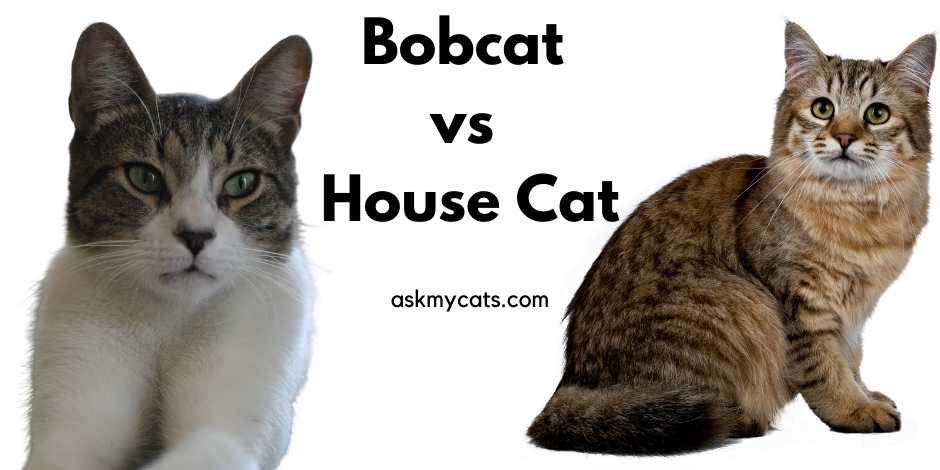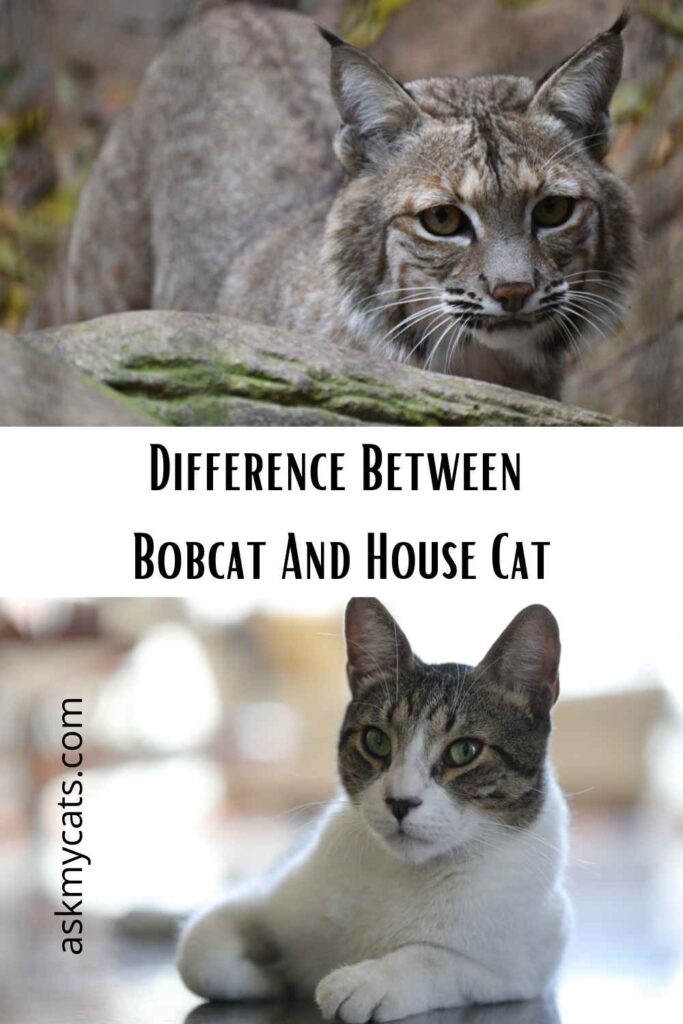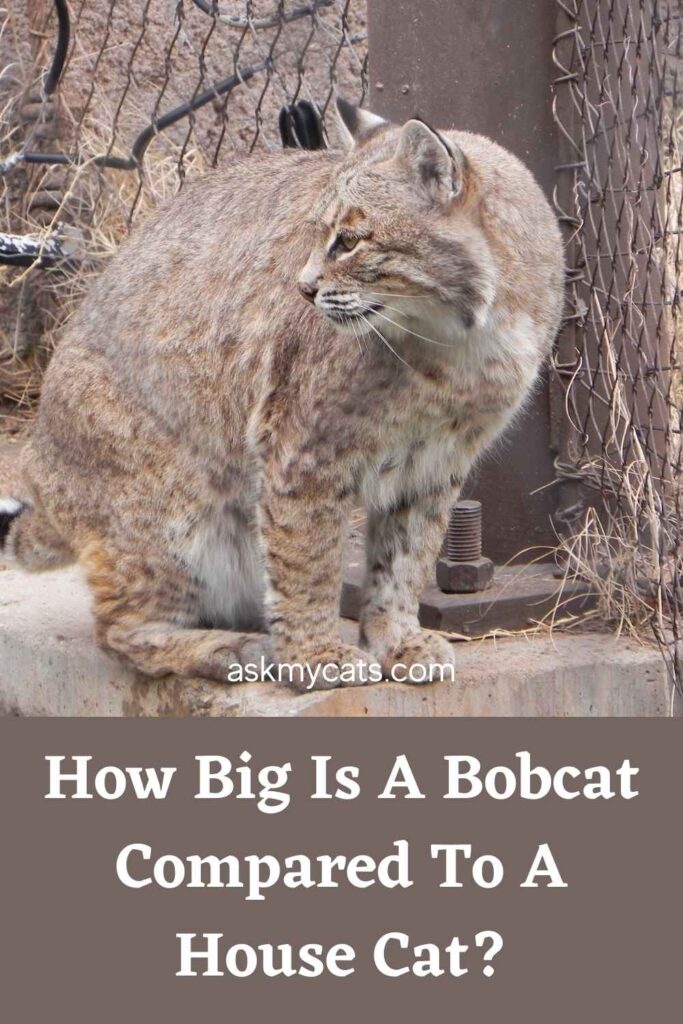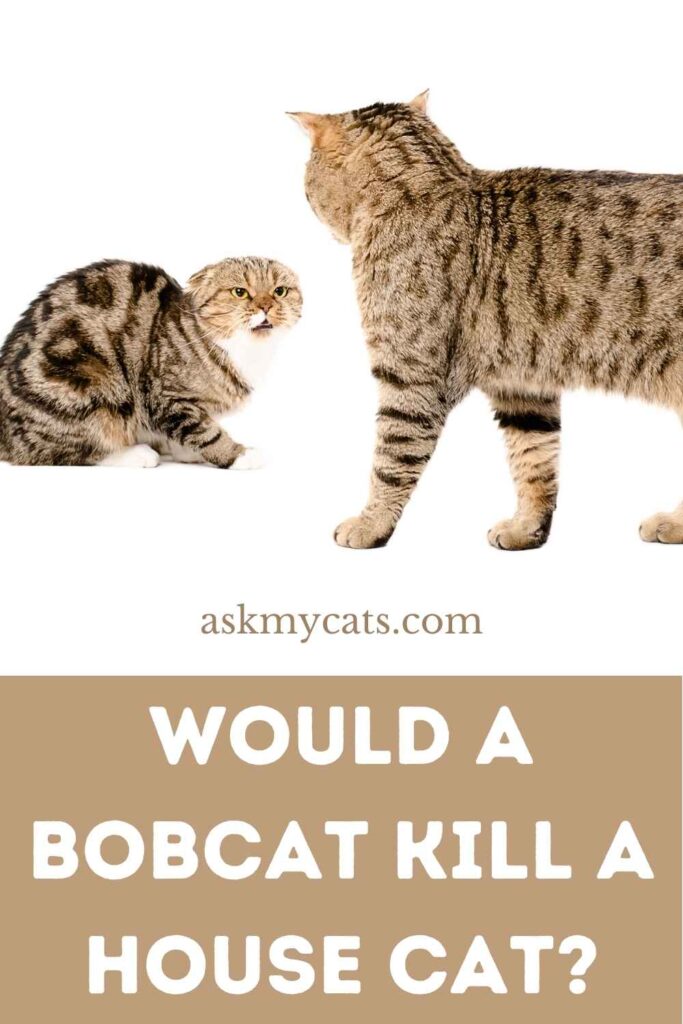Bobcats (Felis Rufus) can be seen in almost any territory, but they are uncommonly seen. In their natural environments, they shun human touch and stick to themselves.
While some domestic cat breeds resemble bobcats, there are significant variations.
The main difference between a bobcat and a house cat is that bobcats are double the size of other domestic cats.
Bobcats have black spots in their hair and dark streaks on their limbs, which is quite different from house cats. Their back legs are elongated and their feet are broad. The short, bobbed tail is easy to see.


Give Your Cat the Perfect Day
Get the Free Ebook!
What Is The Difference Between A Bobcat And A House Cat?
Wild kittens’ behavior differs significantly from that of their domesticated peers. By paying attention to their looks and habits, you will tell them apart.
There have been reports of domestic cats mating with wild bobcats, but no proof has ever been found by genetic testing.
Bobcats aren’t your ordinary house cat; they can weigh up to 30 pounds and are about twice the size of a domestic cat.

The majority of bobcats have a brownish-red underbelly and a white underbelly. Bobcats get their name from their short, stubby tails that look cut-off or “bobbed.”
Bobcat tracks are distinguished by their scale (approximately 1 3/4” long by 2” wide) and four toes. Since bobcats have retractable paws, their tracks do not reveal claw marks.
Bobcats are also mistaken for their nearest relative, the lynx, but lynx are much rarer and do not occur in Vermont.
Bobcats, like all cats, are carnivores that prey on rodents, rabbits, squirrels, and birds. They are capable of taking down large prey, such as adult deer, but prefer to hunt smaller wildlife.
Bobcats are great hunters who stalk their victims with stealth and patience before leaping in for the kill.
They are solitary and can live in a variety of dens, including one “primary den” (usually a hollow log or rock shelter) and many “auxiliary dens” (brush piles or rock ledges).
Young bobcats remain with their mother for 9 to 12 months before venturing out on their own until they’ve learned to hunt.
Examine the kitten carefully to see if it follows the standard bobcat anatomy requirements.
Look for yellow eyes with black pupils, wide upstanding tufted ears with sharply pointed tops, and long tufts of fur flowing down the arms.
Like their northern relative, the lynx, baby bobcats have black streaks lining the tops of their ears.
Bobcats have black spots in their hair and dark streaks on their limbs.
Their back legs are elongated and their feet are broad. The short, bobbed tail is easy to see.
Examine the kitten’s average size—bobcats are double the size of other domestic cats.
Keep an eye on your kitten’s patterns and behavior.
Bobcats, even though they are young, are more aggressive than domestic cats. They are afraid of strangers and will sometimes target them.
Keep an eye out for the kitten’s footprints, also known as spoor.
“It’s trail is very narrow since its hind feet prints lay directly on top of, or in ‘register’ with, its forefeet prints, as if made by a two-legged horse,” says Audubon Society nature guide James A. McMahon.
Bobcats are even more water-friendly than domestic cats.
Examine the appearance of domestic kittens that mimic bobcats and compare it to your kitten.
With their long hind legs and narrow tails, Manx cats resemble bobcats on the surface, but they have significant variations.
They miss the long facial tufts of bobcats and have shorter ears and snouts.
Baby bobcats have characteristic fur patterns and tawny reddish-brown fur, but Manx kittens do not.
Maine Coon kittens have bobcat-like ears, but they don’t have short tails like bobcats.
| BOB CATS | HOUSEHOLD CATS |
|---|---|
| 1) Larger in size than domestic cats. | 1) Smaller in size. |
| 2) About twice the weight of normal cats. | 2) About half the size of bobcats. |
| 3) They have long hind legs and short tails. | 3) They have short legs and medium-sized tails. |
| 4) They are found especially in the United States. | 4) They are found all over the world. |
Interesting Read: Can Bobcats Be Black? Myth or Reality?
How Big Is A Bobcat Compared To A House Cat?
Bobcats are about twice the size of normal household cats with comparatively long hind legs.
Bobcats are medium-sized wild cats that weigh between 11 and 68 pounds for males and 9 to 33 pounds for females.
Bobcats stand 18 to 23 inches tall at the shoulder and can grow to be 31 inches long from nose to tail.

The bobcat’s hair is a variety of browns, greys, and whites, with black spots and markings on the legs.
With a ruff of fur across the ears, the fur is dark and almost fuzzy. The bobcat’s ears, like those of its relative the Canada Lynx, are black with a contrasting white patch on the back and black tufts on the ear top.
Bobcat is short for bob-tailed cat, which describes one of its most distinguishing features: a short, bobbed tail.
Bobcats (Felis Rufus) are the most common wild cat in the United States, with an estimated 1 million wild animals. Bobcats are also hunted for their fur in some regions.
The bobcat used to be found around the entire continent of North America, but its range has narrowed to almost entirely within the United States.
Bobcats are adaptable species and can live in various environments such as deciduous and coniferous woodlands, semi-deserts, and swamps.
The cats prefer areas of shade and are not present in Canada’s treeless prairies.
Male bobcats can take prey that is much bigger than them, such as white-tailed deer, although females and young cats prefer smaller prey.
Rabbits, rats, crab, crayfish, birds, bats, and snakes are among the species and insects that the bobcat catches. Bobcats are known to consume grass and have also been seen stealing fruit from plantations.
Bobcats are mainly diurnal (day-living) animals, although those living near human settlements have evolved into nocturnal (night-living) species to avoid being hunted.
Female bobcats are lonely creatures with home territories ranging from 1 to 37 square miles. Male bobcats have no fixed territories and can travel hundreds of miles in search of females and food.
Male bobcats are not included in the care of the kittens. Female bobcats have a 50-70-day gestation cycle before giving birth to up to six kittens in a secluded den.
For the first nine days of their lives, the kittens are blind and will nurse from their mother for two months.
They’ll spend about a year with their mum, learning to hunt and care for themselves, before leaving to find their own territories.
Would A Bobcat Kill A House Cat?
Bobcats do not usually kill a house cat because they are their feline companions. Bobcats hunt and consume a wide range of mammals, from tree squirrels to deer, but they also prey on goats, fowl, and domestic pets including rabbits, cats, and dogs.

Bobcats rarely pose a threat to humans, preferring to hide when confronted. They will defend their cubs and strike back if cornered, sick, or hurt.
Their sharp claws and teeth, like those of any cat, can cause severe injury, and they are incredibly swift and agile.
Bobcats usually breed in the months of February and March.
However, latitude, longitude, height, temperature, photoperiod, and perhaps prey abundance all affect the breeding season.
The male bobcat abandons the female to raise the young on her own. 2-3 kittens are born every 60–64 days. They open their eyes after ten days and are excited to investigate their surroundings.
Bobcats have a reputation for being excellent hunters. These predators had a lot of popularity.
They’ve been so good that they’ve expanded to nearly every state in the United States.
Delaware is the only place where bobcats aren’t found.
There are approximately 3 million of these feline predators roaming the world, feeding on a variety of living species.
The rabbit is their preferred food, but bobcats can eat a variety of species, including rodents, lizards, snakes, and other small mammals. And, if your pet is in a position where a bobcat can get to it, that means your cat.
Both cats, including wildcats like bobcats, are obligate carnivores. This ensures that meat provides them with all they need.
Consuming the meat of other species provides them with all of the foods, vitamins, minerals, and calories they require.
Bobcats are almost often on the hunt as a result of this. When there’s food to be had, bobcats are able to hunt, and they don’t discriminate much on what constitutes a meal.
Bobcat attacks on pets haven’t always been so common, but they’re becoming more common and numerous.
Every year, it seems that bobcats are targeting pets more often, and this is true. The natural ecosystem of bobcats is becoming living space for humans as the human population grows.
Bobcats, on the other hand, have responded well to this transition rather than fleeing. While much of their former prey becomes harder to come by, new possibilities emerge.
Often people leave their dogs or cats unattended in their yards. These people also mistakenly assume that their walls or fencing are sufficient to shield their dogs.
However, if you want to keep bobcats out, you’ll need more than a small wall. These felines are extremely athletic and fast. The minimum work required to scale your back wall to get to your pet inside is well worth it.
A quick internet search would discover that bobcat attacks are far too frequent. Although bobcats seldom target humans, they do pose a threat to livestock. Bobcats, on the other hand, isn’t the heaviest of animals.
When fully grown, bobcats weigh about 20 pounds, but they won’t be able to take on a Rottweiler or other large dog.
Smaller pets, such as dogs under 20 pounds and almost any house cat, can provide a bobcat with a simple meal.
Bobcats can hunt and consume a wide variety of prey. They’ve been blamed for the deaths of numerous horses, cattle, lambs, goats, ducks, and other fowl, in addition to backyard pets like small dogs and cats.
Per year, bobcats are thought to kill over 10,000 sheep and lambs in the United States.
Fortunately, attacks on humans are very rare, but they have occurred in the past with cats that were thought to be infected with the rabies virus.
Can Bobcats Be Domesticated?
No, it’s not true. Certainly not. You can’t turn a bobcat into a domesticated animal, no matter how young it is.
When a bobcat is reared by people, it may appear friendly at first, but it will eventually turn on you, usually with disastrous consequences for the bobcat, any pets you may have, and possibly humans (especially children).
Keeping a bobcat may be unlawful depending on where you reside.
You’ll almost certainly need permits even if it’s not prohibited. This is something you should not contemplate from an ethical standpoint.
These are wild animals who should be allowed to roam freely. Trapping or breeding them for commercial purposes is unethical and should be prohibited everywhere.
There is a significant difference between domestication and taming, which many people are unaware of and use domesticate interchangeably with the word tame.
Domestication is a term that refers to a genetic modification that occurs across several generations (and is thus passed down from parents to offspring).
Domestication of wolves is estimated to have originated around 10,000 years ago when humans were shifting from agricultural to agricultural societies.
As wolves became tamer and humans began to use them for tasks like hunting, herding, and protection, it most likely began as natural selection and then evolved into selective breeding.
Can Bobcats Breed With Domestic Cats?
Yes, bobcats can breed with domestic cats and a pixie bob is the child of a bobcat and a domestic cat. They’re mostly unintentional crossbreeds.
Pixie bobs are half wildcats, not to be confused with domestic cats, and are not suitable for living indoors. They can be devoted and loving, but I wouldn’t advocate getting one as a pet because they bond to one person and one person only.
Everyone else is prey, a possible threat, or meh—don’t know, don’t care.
Although bobcats and house cats are not related, given the prevalence of hybrids between house cats and other wild cats, as well as hybrids between cats of different lineages, such as the pumapard (puma/leopard hybrid), the potential of a bobcat-house cat hybrid is a significant probability.
Hybridization would be highly unlikely, given that bobcats normally regard house cats in the same way that wolves and coyotes do domestic dogs.
Frequently Asked Questions
Does Bobcats meow like a house cat?
They hiss, growl, purr, and snarl much like most cats. They also make cries that resemble an infant weeping. The bobcat squeal sounds eerily similar to a child or woman’s cry. Over the winter breeding season, male bobcats make the sound when competing. They are solitary wild animals that only come together to spawn in the spring. During courtship, the male makes noises to draw the females’ attention.
How do I know if my cat is mixed with a bobcat?
Take note of the head and eye shapes. Bob-kittens have circular eyes and oval-shaped heads, while domestic kittens have round eyes and oval-shaped heads. If you happen to come across bobcat kittens in the wild, the only thing you can do is keep your distance and avoid interfering.
What domestic cat looks like a bobcat?
Bobtail is a kind of bird native to the United States. Some pet owners adore the appearance of smaller North American wild cats and dream of owning a bobcat-like house cat. They were, however, produced by breeding wild cats with naturally occurring bobtail genes rather than real bobcats.
Final Words
Bobcat assaults on cats are uncommon in most regions.
However, bobcats could be hiding near your home if you live on the edge of town near a more rural location.
Although large dogs are rarely attacked, small pets such as cats will become easy prey and vanish from your yard if you aren’t cautious.
If you suspect a bobcat is living near your house, take precautions. You don’t want your pet to be the next meal for it!
Shoot your questions in the comments section below!
Also, check out Are Female Cats Better Hunters Than Male Cats?

We have a bobcat roaming though our neighborhood. When it walks through the yard it “meows” is that normal? I would think it would be silent so that it could hunt. Thank you.
Hello rita,
Its totally normal for bobcat to meow while roaming.
Nothing to worry.
Have a nice day.
I have a Bobcat / Cat cross breed. He was hit by a car and injured pretty bad. He was crying and he let me pick him up. I took him back to my house and treated him and reset his broken leg. He had a large piece of his fur ripped off of his head and I treated it and put Neosporin on it for a long time. I kept my distance and treated him with total kindness. He had bitten me several times, but I gained his trust. I nursed him back to total health. We have bonded beyond belief. He stays in my garage and I feed him very well. I have to let him out every day because he is a wild animal and needs his freedom. His name is Lucky and I call for him at night, he does come home and we sit together. he gets on my lap and I pet him and talk to him. We both respect each other, I have a deep bond with him, and I dearly love him. I know he is wild and I respect his freedom. You have to when it comes to a wild being. I will take care of him till he decides other wise. It has been a fantastic experience for me to have such a beautiful animal. He is 28 inches long and 15 inches high and weighs 26 pounds. He loves my Dalmatian and they get along with each other. Templar will lick his head and face and Lucky just lets him do it. In the spring and summer when I take templar out for a walk Lucky will walk with us. It is truly Awesome that I can have these two together. I love it. Thanks for letting me share this experience with you !!